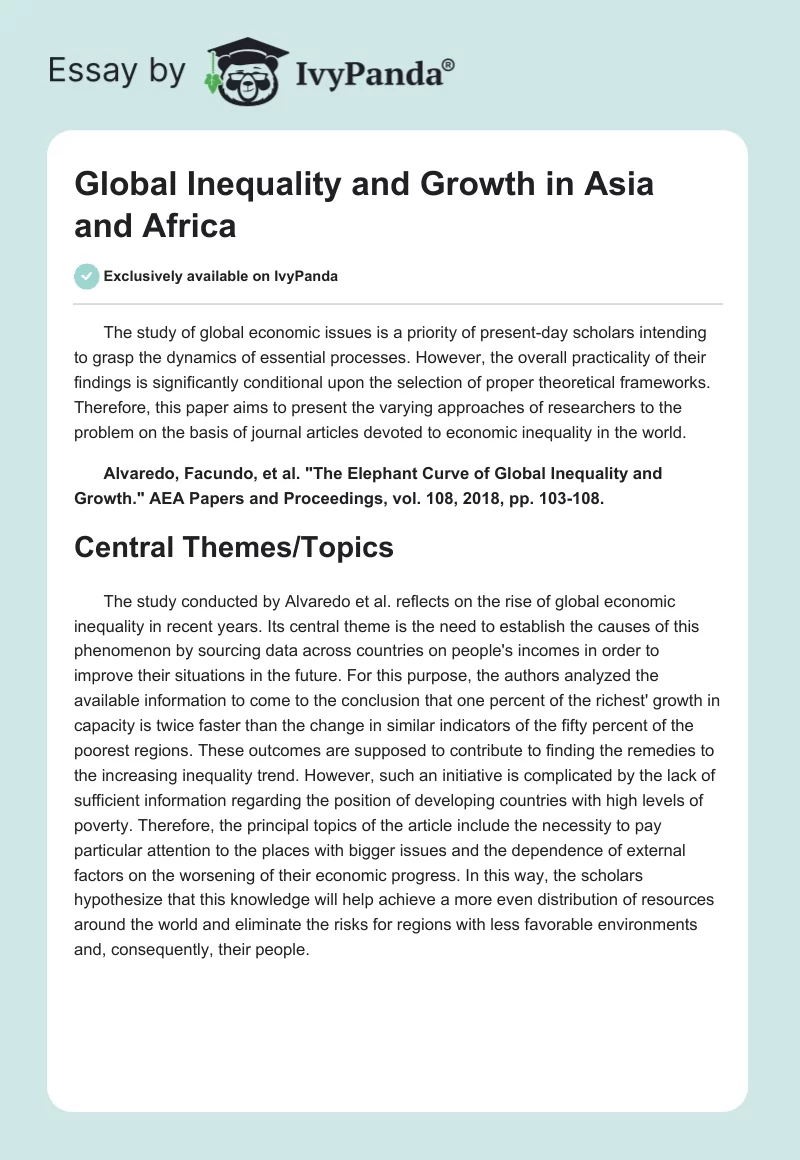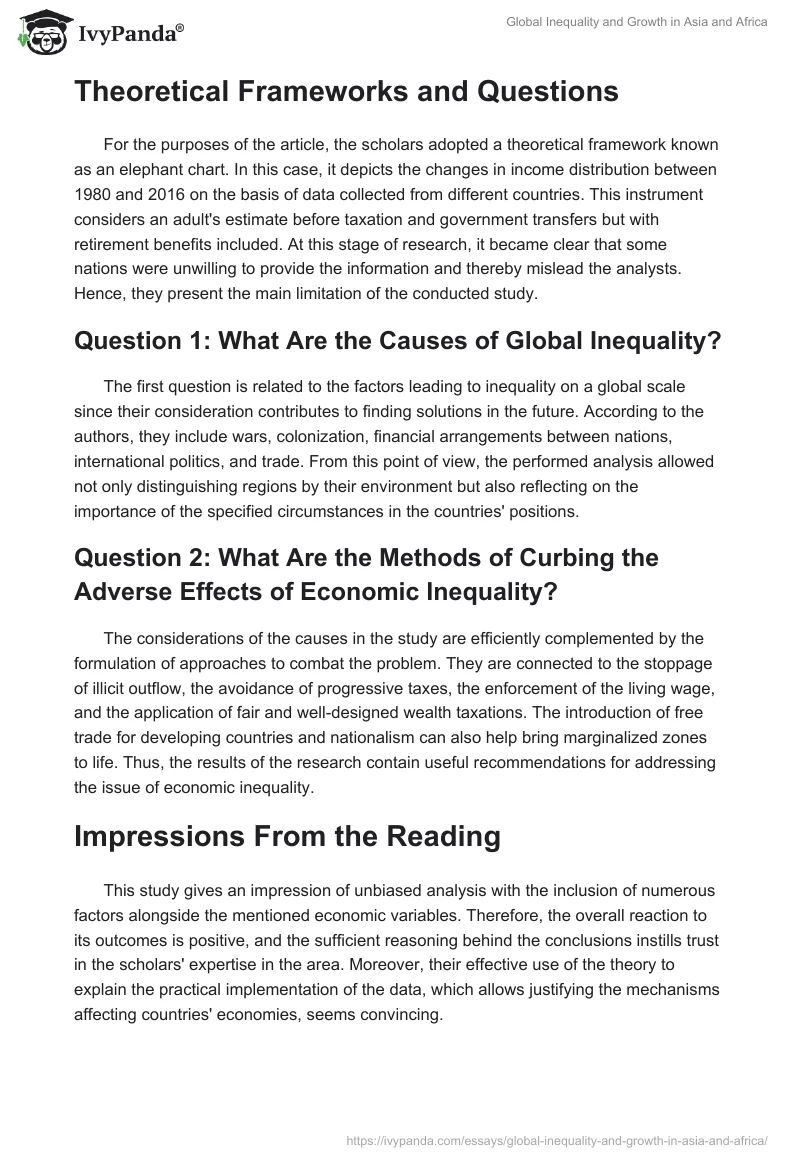Introduction
The study of global economic issues is a priority of present-day scholars intending to grasp the dynamics of essential processes. However, the overall practicality of their findings is significantly conditional upon the selection of proper theoretical frameworks. Therefore, this paper aims to present the varying approaches of researchers to the problem on the basis of journal articles devoted to economic inequality in the world.
Study #1
Alvaredo, Facundo, et al. “The Elephant Curve of Global Inequality and Growth.” AEA Papers and Proceedings, vol. 108, 2018, pp. 103-108.
Central Themes/Topics
The study conducted by Alvaredo et al. reflects on the rise of global economic inequality in recent years. Its central theme is the need to establish the causes of this phenomenon by sourcing data across countries on people’s incomes in order to improve their situations in the future. For this purpose, the authors analyzed the available information to come to the conclusion that one percent of the richest’ growth in capacity is twice faster than the change in similar indicators of the fifty percent of the poorest regions. These outcomes are supposed to contribute to finding the remedies to the increasing inequality trend. However, such an initiative is complicated by the lack of sufficient information regarding the position of developing countries with high levels of poverty. Therefore, the principal topics of the article include the necessity to pay particular attention to the places with bigger issues and the dependence of external factors on the worsening of their economic progress. In this way, the scholars hypothesize that this knowledge will help achieve a more even distribution of resources around the world and eliminate the risks for regions with less favorable environments and, consequently, their people.
Theoretical Frameworks and Questions
For the purposes of the article, the scholars adopted a theoretical framework known as an elephant chart. In this case, it depicts the changes in income distribution between 1980 and 2016 on the basis of data collected from different countries. This instrument considers an adult’s estimate before taxation and government transfers but with retirement benefits included. At this stage of research, it became clear that some nations were unwilling to provide the information and thereby mislead the analysts. Hence, they present the main limitation of the conducted study.
Question 1: What Are the Causes of Global Inequality?
The first question is related to the factors leading to inequality on a global scale since their consideration contributes to finding solutions in the future. According to the authors, they include wars, colonization, financial arrangements between nations, international politics, and trade. From this point of view, the performed analysis allowed not only distinguishing regions by their environment but also reflecting on the importance of the specified circumstances in the countries’ positions.
Question 2: What Are the Methods of Curbing the Adverse Effects of Economic Inequality?
The considerations of the causes in the study are efficiently complemented by the formulation of approaches to combat the problem. They are connected to the stoppage of illicit outflow, the avoidance of progressive taxes, the enforcement of the living wage, and the application of fair and well-designed wealth taxations. The introduction of free trade for developing countries and nationalism can also help bring marginalized zones to life. Thus, the results of the research contain useful recommendations for addressing the issue of economic inequality.
Impressions From the Reading
This study gives an impression of unbiased analysis with the inclusion of numerous factors alongside the mentioned economic variables. Therefore, the overall reaction to its outcomes is positive, and the sufficient reasoning behind the conclusions instills trust in the scholars’ expertise in the area. Moreover, their effective use of the theory to explain the practical implementation of the data, which allows justifying the mechanisms affecting countries’ economies, seems convincing.
Conclusion
The article under consideration is well articulated and supported by adequate substantial evidence. Moreover, its scope is not limited by the initial intention to demonstrate the current positions of the world countries in relation to their economic indicators but also covers the causes of problems and the methods to address them. In this way, the study performed by the scholars has both theoretical underpinning and practical implementation, which allowed me to learn about the connection between these two aspects.
Study #2
Novokmet, Filip, et al. “From Communism to Capitalism: Private Versus Public Property and Inequality in China and Russia.” AEA Papers and Proceedings, vol. 108, 2018, pp. 109-113.
Central Themes/Topics
The central theme of the study conducted by Novokmet et al. is connected to the interrelation of inequality and private, and public property analyzed with the use of data from Russia and China. The authors hypothesize that varying strategies of the countries in the transition to a mixed economy provide different results. According to them, the process of acquiring public assets for the regions implied particular patterns, including “voucher privatization” in Russia and the slow processes in China, resulting in the value fall. The scholars further continue discussing the composition of private wealth and conclude on China’s rapid growth of housing value compared to Russia’s slower pace in this regard. The decline of public property in the countries was confirmed to be aligned with the world trends. As for income inequality, it was typical for both China and Russia but more drastic in the case of “voucher privatization.” As a result, contrasting the gradual and wide scope reform in China to the rapid transfer of assets in Russia led to the conclusion of the former’s more favorable economic environment.
Theoretical Frameworks and Questions
The analysis was based on a comparison of financial indicators and corresponding strategies as the only applicable theoretical framework. Thus, the main factors considered for making conclusions on the difference between China and Russia regarding economic inequality included the methods of transition, the composition of private assets, the decline in public property, and the national statistics. Their combination demonstrated the influence of the specified circumstances on the uneven distribution of resources.
Question 1: How Can the Negative Consequences of Economic Transitions be Eliminated?
From the study, it is clear that the transitions of countries’ economies are inevitably accompanied by the creation of inequality in citizens’ income rates. Hence, the question raised by the article is connected to the need to apply measures to mitigate such risks. For example, this task can be addressed by comparing their experience with other regions. As a result, it will help elaborate an optimal approach to the initiative.
Question 2: What Are the Constraints on Top Incomes Placed by China and Russia?
The mentioned shifts in the countries’ economies evoke concerns of researchers since they directly influence the well-being of their citizens. More specifically, such transitions create particular constraints on top incomes. In Russia, they are explained by the plundering of essential resources, whereas in China, they derive from a strong ideology. In this way, the elimination of these obstacles is possible when adequately addressing the described issues.
Impressions From the Reading
The article seems to be an invaluable source of information regarding the vital economic processes of the countries adversely affecting their citizens’ income inequality. Indeed, any drastic changes can lead to such a negative outcome and, therefore, should be addressed through efficient measures. Otherwise, the existing risks will be complemented by various complications, including the discontent of people and the workforce’s excessive outflow to foreign markets.
Conclusion
In conclusion, a thorough analysis of the economic history of China and Russia is critical for finding a solution to the world’s issues related to inequality. Their experience adds to the risks of other countries with more favorable environments, which I learned in the process of analyzing the source. Moreover, it allows predicting the possibility of problems in the case of a required shift in any region regardless of its position, and this fact increases the value of conducted research.
Study #3
Assouad, Lydia, et al. “Extreme Inequality: Evidence from Brazil, India, the Middle East, and South Africa.” AEA Papers and Proceedings, vol. 108, 2018, pp. 119-123.
Central Themes/Topics
The article written by Assouad et al. reflects on the situations of inequality in Brazil, India, the Middle East, and South Africa. Its central theme is the dynamics of the issue in these regions, known for their extreme levels. However, the authors’ intention was not only to analyze the data but also to deal with corresponding limitations by combining a variety of sources to demonstrate the real positions of the countries. In this way, they managed to reveal the gaps between the representation of the government and citizens’ surveys. To prove the significance of these locations for the study, the scholars hypothesized that the structure of extreme inequality matters and compared critical indicators with other places. In the end, they came to the conclusion that the problems stemmed from the past social hierarchies as well as ownership rights. Therefore, the principal topics covered by the paper are the difference in information for analysis depending on its source, the critical position of the regions on a global scale, and the factors affecting inequality.
Theoretical Frameworks and Questions
For the purposes of the study, the scholars adopted the theoretical concepts connected to national macroeconomic accounts and complimented them with tax data and household surveys. Hence, the performed analysis was based on such considerations as the proportions of total income, survey and fiscal data, and the distribution of resources in the specified countries. This approach was helpful for overcoming the limitations of the possible data bias and the demonstration of real situations.
Question 1: What Were the Factors Affecting Between-Country Inequality?
The study implied the provision of circumstances negatively influencing the overall economic environment and their citizens’ prosperity. It revealed the significance of the geography of oil ownership, this resource’s transformation into financial endowments as well as rigid social traditions. Thus, the given conditions were of crucial importance in the process of economic formation and transition for some of the considered countries and explained the current difference between them.
Question 2: What Are the Characteristics of the Regions with Extreme Levels of Inequality?
According to the research outcomes, the places with relatively high levels of inequality were characterized by similar circumstances. They included a dual social structure defined by the existing hierarchies and, consequently, the top 10% income shares exceeding 50% of national income. These results confirmed the similarity of the regions with such issues and revealed the comparable mechanisms of their economies, adding to the negativity of their present positions in the world.
Impressions From the Reading
This source efficiently complements the data known on the topic by providing a thorough analysis of the world’s situation. During the analysis, I learned that the consideration of several regions within a single study contributes to making analogies between the essential processes affecting the countries’ situations in terms of inequality. Hence, it is beneficial for further elaboration of practical measures designed specifically for their environments and gives an impression of the possibility of combating the identified problems.
Conclusion
To summarize, the article considering economic inequality in Brazil, India, the Middle East, and South Africa proves the existence of similar patterns in the development of regions with comparable historical characteristics. Its outcomes significantly expand the knowledge of the issue while ensuring the understanding of vital processes in this area. In this way, it can be concluded that the analysis of a combination of regions instead of focusing on one country is an advantageous method for the purposes of providing a theoretical basis for actions.
References
Alvaredo, Facundo, et al. “The Elephant Curve of Global Inequality and Growth.”AEA Papers and Proceedings, vol. 108, 2018, pp. 103-108, Web.
Assouad, Lydia, et al. “Extreme Inequality: Evidence from Brazil, India, the Middle East, and South Africa.”AEA Papers and Proceedings, vol. 108, 2018, pp. 119-123. Web.
Novokmet, Filip, et al. “From Communism to Capitalism: Private Versus Public Property and Inequality in China and Russia.”AEA Papers and Proceedings, vol. 108, 2018, pp. 109-113. Web.


